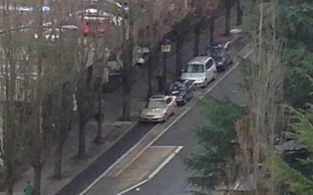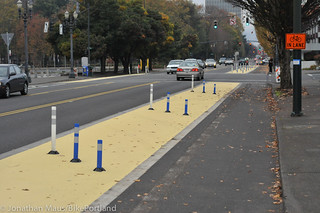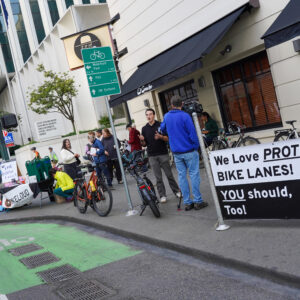
issue that needs to be addressed in a
permanent design.
(Photo sent in by reader Brian M.)
The private task force that developed the NE Multnomah Street Pilot Project met last week and decided that Portland’s marquee protected bikeway project should be a permanent fixture in the Lloyd District.
According to Lindsay Walker, head of the bicycle program for transportation management association Go Lloyd, “The stakeholders were all in agreement that we’d like to see the pilot project transition to something permanent.”
The task force is made up of PBOT staff, Lloyd District real estate developers, representatives from the Lloyd Center Mall (who are planning a new “grand entrance” on Multnomah), the Rose Quarter/Portland Trail Blazers, the Portland Development Commission, and a citizen activist who works in the Lloyd.
Walker says that they spent most of the meeting discussing what’s working, what’s not (and how to fix the problems), and listening to feedback from adjacent property owners. While some significant “operational issues” remain (the biggest one being vehicles blocking the bikeway), there have been enough observed benefits of the new bikeway that it’s not going anywhere.
Now it’ll be up to a public process from PBOT to decide what design changes will make the bikeway work even better. Since it was installed about 16 months ago, the bikeway is already showing significant signs of wear and tear. Many of the plastic bollards have been run over, large concrete planters have been moved, the yellow paint in the buffer zone is faded, and so on. A permanent facility would need more separation provided by concrete (not just paint) in order to keep people from parking cars in the bikeway.
Craig Harlow, a citizen representative on the task force, told us he’s “cautiously optimistic” about the future of NE Multnomah. “I’ll be looking forward to plenty of future discussion about a possible ‘world-class bikeway’ design, as was heralded by PBOT staff when the pilot project was being planned.”
Harlow hopes that some of the upcoming discussion will include the topic of a new bicycling and walking bridge over I-84 on NE 7th Avenue. The time might be right to talk about that project, given the dramatic changes the Lloyd District has seen with the addition of the new streetcar line, this new bikeway on NE Multnomah, the current construction of the 657 unit Hassalo on Eighth project, and so on. “It’s all speculation,” Harlow wrote via email about a new I-84 bridge, “but all very germane to the discussion of how a world-class remake of NE Multnomah will address the evolving and growing demand of low-car residents and other users of the Lloyd District in the future.”
“Portland is now playing catch-up when it comes to implementing separated bikeways. We have a chance with this project to get back into the game.”
— Craig Harlow, task force member
Another new wrinkle in this project is a Bureau of Environmental Services project that will include major sewer pipe work in the middle of NE Multnomah. Walker said the potential of that project puts any plans for Multnomah in “a bit of a holding pattern.” If BES does indeed tear up Multnomah it could be an opportunity to build a new, high-quality bikeway from a clean slate. But on the other hand, it could delay any improvements indefinitely.
Regardless of a future BES project, Walker says in the immediate short-term we can expect to see the paint and plastic wands “spruced up or replaced since they already look much older than their age. In the longer-term, there seems to be support from property owners along the corridor to replace the plastic wands entirely — perhaps with more planter barriers the entire length of the street.
With its proximity to major commercial destinations, housing, transit, and hotels, NE Multnomah can retain its position as Portland’s marquee protected bikeway; but to keep up with other leading cycling cities, it sorely needs a facelift. Or, as Harlow puts it, “With precedents already being set in many other US cities, Portland is now playing catch-up when it comes to implementing separated bikeways. We have a chance with this project to get back into the game.”
— Browse our comprehensive archived coverage of this project.







Thanks for reading.
BikePortland has served this community with independent community journalism since 2005. We rely on subscriptions from readers like you to survive. Your financial support is vital in keeping this valuable resource alive and well.
Please subscribe today to strengthen and expand our work.
If they succeed in putting in a concrete barrier, I would like to suggest bikeportland set up a betting pool on how long it takes a driver to get a car stuck on the wrong side of the barrier.
Considering last year someone got a car stuck on the 205 bike trail (in the middle of the bridge!), I’m guessing just a matter of days (maybe hours).
It’s going to be like a honey pot for bees…or the Washington Park MAX tunnel for SUVs.
“some significant “operational issues” remain (the biggest one being vehicles blocking the bikeway”
Nothing a few $150 parking tickets wouldn’t fix, and quick. Or, what would the city do if these people had parked in the main roadway, and left their cars blocking one of those lanes? They’d tow them. Seems to me a “lesson” is what’s needed here, rather than an infrastructure change. 7th Avenue bike bridge, awesome idea.
Yes and no. I’m all for enforcement, but if people are parking in the wrong place en masse, then there is something wrong with the design and how it communicates the desired behavior. The concept of parking in what is essentially the middle of the street is foreign to most people. This is a design problem.
How did this problem get fixed on Broadway around PSU? Seems like that has sorted itself out and people rarely park in the bike lane.
People cruise 15+ mph over the speed limit en masse, because of a lack of enforcement.
Which is why I said yes and no. People know what the speed limit is and choose to ignore it. I don’t think it’s the same here with the parking.
I’m all for full-on, zero tolerance enforcement for most things, speeding especially. I just also know that many times we-intentioned people are confused by situations like this.
“well-intentioned”
True, some of those people parked in the bike line are probably well intentioned. The point I was trying to demonstrate is there has to be some kind of enforcement, even if it’s just a warning on each windshield.
Some of them are, but a lot of them just come from parts of the world where you can park wherever you damn well please. Remember, there are many parts of the Metro area where parking in your front yard is both accepted and commonly practiced.
There are many parts of PORTLAND where parking in your front yard is both accepted and commonly practiced.
A horrible trashy practice it is.
All great news. That bike bridge over 7th is long overdue.
Although it’s depressing to see how quick and effective a closed doors private group can be compared to the long drawn out public processes. If I remember right, this whole Multnomah project went from nothing to completed in less time than the north Williams project has taken.
there was a public process that took awhile, and there was a potential derailment re the 12th avenue overcrossing. the difference might be that the disaffected interest who had to be assuaged here was not longtime beleaguered residents but commercial freight.
Jonathan, I strongly urge you to cease posting about “stakeholders!” “Stakeholders” are infinitely worse than “cyclists!”
As I have taken pains to point out numerous times, “stakeholder” in your context is a dreadful bureaucratic euphemism that eviscerates the stupendous awesomeness of true stakeholders, like Buffy Summers (many small stakes) and Arthur Holmwood (one extremely, extremely, large stake).
The noble and necessary task of true stakeholders is to impale and extirpate every form of nastiness that creeps, crawls, or shambles upon our glorious planet. Fortunately, in our fair metropolis we now aver the presence of “Grimms” to assist in this essential work. Spurious and ephemeral “stakeholders” can only impede their essential activity.
And mind the sunglasses. Especially when cycling.
I love that the first headline photo accompanying this article shows like, seven cars parked illegally in the cycle track.
The picture with no vertical delineators to deter ingress?
I think the picture is wildly inappropriate. Considering that they added physical barriers and have had these barriers established for a long time (which helps to change behavior), what relevance does that picture have to this story now?
I think the two biggest problems with the current design are the nonstandard (also ugly) beige paint, and poor provision for left turns off Multnomah.
As for the paint, the easy solution is to replace the beige with diagonal hashmarks, the standard treatment for “no-go” zones.
Not so sure what the best practice is for easing left turns from protected bikeways like this. One problem I’ve had trying to turn off of Multnomah is that sometimes, right at the point where I want to move over (well ahead of vehicles approaching from behind) there’s a planter in my path and I have to wait until it’s too late to merge appropriately. Then I find myself having to stop at the light and do a “Copenhagen left”, delaying me an extra cycle. Again, I’m not clear on exactly what the right solution looks like, but it definitely requires that the gaps between the planters (or other barrier) be placed in a way that doesn’t inhibit safe left-turn movements, nor in a way that makes it “surprising” for motorists when we cross over to make a left turn.
I think you answered your own question about the left turns, as the Copenhagen left is the way that those turns are made in almost all separated bike facilities. While it does require a little more patience and an extra light cycle, that is price paid for a better facility. Think of it this way – if the cycle track was elevated to curb level (which perhaps it should be to deter parkers), would you jump off the curb to turn left?
“if the cycle track was elevated to curb level, would you jump off the curb to turn left?” Yes. I hop curbs at speed every day. But point taken.
if the workaround is a copenhagen left, maybe it is not a “better” facility
Also, yes a bike bridge across the freeway would be awesome. 12th isn’t terrible, but it does require sharing a lane with cars, and some of the movements required before and after bridge are probably scary for some cyclists.
But that bridge will be a multimillion dollar, multi-year project. The Multnomah work needs to happen first.
Curbing to replace the planters would prevent confused drivers from parking in the bike path, allow a wider bike lane and sweeper access, and eliminate most of the need for painting/repainting. Add some clear “no cars” markings and cautionary signage at driveways.
There seems to be a vocal desire for separated cyclepaths, and here we have one in the making – seems like a good thing.
The solution to make this more permanent is pretty simple – make it a real cycletrack, with a shouldered, elevated surface at sidewalk level that ramps down at intersections. It could also be widened by a foot or two, and still maintain separation. That will also resolve the parking issue, as people normally do not park on curbs. This would be more attractive than concrete barriers.
Elevated cycle track, usually concrete, costs about $350 per foot, so your one way raised cycle track comes out to about $90k per block, or $1.8M a mile, compared to about $5k/block $110k/mile for some curbing – and that’s just one side of the street. There are more pressing needs in Portland.
What is the cost breakdown if BES ends up rebuilding the entire street, curb to curb? Would rebuilding a concrete elevated cycletrack in concrete cost much more than new asphalt and a free-standing curb for separation? An elevated cycletrack that slopes to the street would have the added benefit of being very long lasting, and stay much cleaner because the road debris would get trapped in the gutter (which would no long be the bike lane!) If the whole road gets rebuilt, I would love to see a profile with a low spot between the bike/parking lanes and a narrow, 18-inch storm water planter separating. This would fit into the Lloyd eco-district goals, keep the bike lane free of cars and debris, control pedestrian crossing of the bike lane with small bridges over the storm water planters and bring a little green to the street.
Sounds like you have a good knowledge of costs. It just makes me think that if true, then the value of the miles (kms) of cycletracks that I rode in Europe must be in the billions of dollars (Euro). Is that 90k per block also the cost of sidewalks? Why are these so much more expensive in the US? And if so expensive, then sure, I am for just throwing down some prefab concrete berms as needed.
Quite frankly the future money (as well as the past money – yeah yeah it done on the cheap) for this project would be better spent elsewhere. Hardly anyone bikes to the Mall.
The ridership numbers on this stretch just aren’t there. Sure they might be once “the development” is occupied. But I doubt it. It sounds to me that the developers and property owners are looking to make it more like the Pearl, which is designed more for pedestrians than cyclists. Not that that is a bad thing. But there are better places for this kind of bicycle infrastructure.
This Sunday tied the highest bike count I’ve ever witnessed on it (not including organized rides) counting myself, there were three of us all the way from the LLoyd Center Max Station to the Rose Garden. The other two turn off before MLK/Grand. And honestly I was only there to once again witness the tumbleweeds blowing to across the “marquee”. I could have easily stayed on the Max to the Rose Garden exit and switched trains there, but it was really nice day.
Of course you also have to ask with the latest budget shortfall, how much will this impact say the 50’s or 70’s highway, or Foster or and other project that might make a real difference other than increase the asking price for condos and rent in future developments.
I would recommend using these. Keeps traffic out. Easy to maintain. Car doors don’t hit them.
http://m.fastcoexist.com/3025799/these-recycled-plastic-dividers-can-create-a-bike-lane-in-a-second
re dividers, etc. anything that makes it more difficult for a cyclist to leave the “protected” lane to execute a left turn (or to pre-empt the conflict with a bus stop) makes the situation worse.
I don’t quite understand the logic of advocating ticketing/towing as a solution to parking in the bike lane. Is your goal punishment or remediation? Because if it’s the latter I don’t understand how those proposals are solutions. Is it that people see the ticketing/towing happening and then refrain in the future? Or that people who were ticketed/towed tell their friends? I don’t imagine it works that way but perhaps I have a poor imagination.
Seems to me that this novel road setup needs clearer signage and whatever other tools road designers use to communicate where traffic should/should not be.
Oh, puhtoowy.